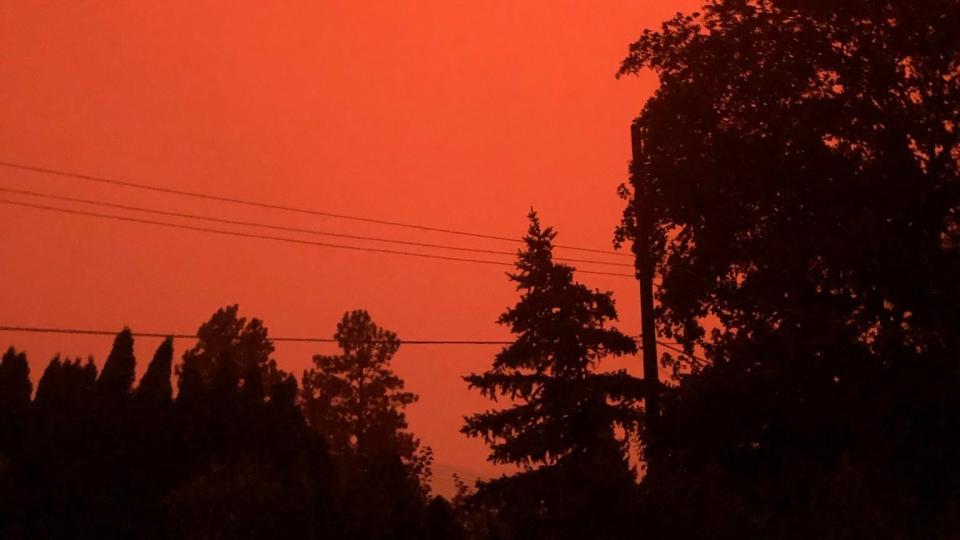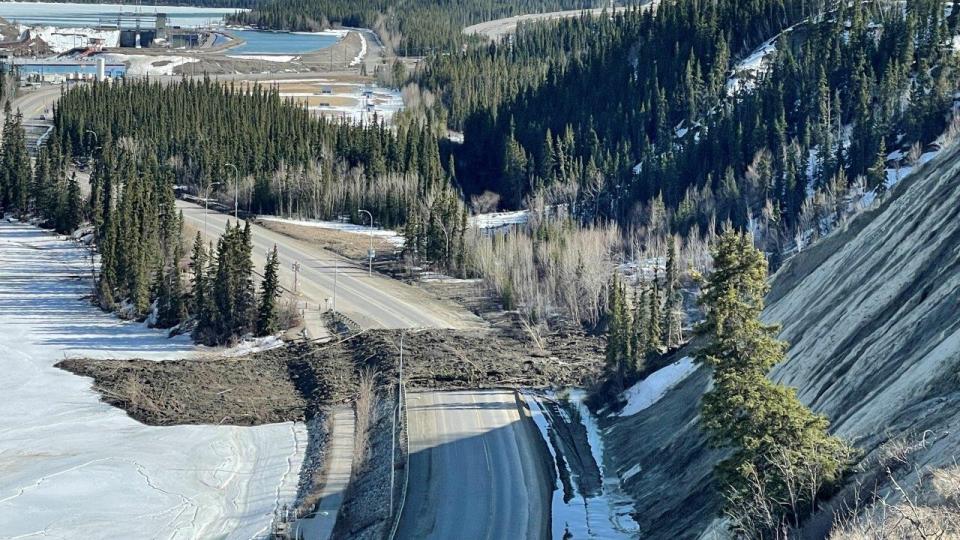A ‘vicious cycle’ — green active transportation gets harder with climate change
Whitehorse’s [Millennium Trail](https://www.whitehorse.ca/living-in-whitehorse/parks-recreation/trails/#1673023277991-0781a3ca-ab31) runs a five-kilometre loop along and over the Yukon River. On an average day, pedestrians and cyclists use the paved, multi-use trail to get around the northern city. April 8 wasn’t an average day, but it’s the kind of day that’s expected to become more common. As the [CBC reported](https://www.cbc.ca/news/canada/north/yukon-whitehorse-landslide-1.6805557), a wave of rocks and silt fell from the nearby escarpment, blocking off a section of the loop.
This landslide isn’t an isolated incident. Unstable ground from melting ice caused a slide that blocked off a part of Millennium Trail for more than a month last year. Plus, as Yukon grows warmer and wetter as global temperatures increase due to burning fossil fuels, these slides are expected to become more common.
This is a somewhat literal example of climate change putting up barriers to active transportation — a means of getting around by walking, biking, using a wheelchair, or even snowshoeing or skiing. Other examples are a bit less blunt, such as cyclists staying indoors because of wildfire smoke, or floodwaters overtaking walkways.

*A landslide starts to cover a Yukon road in rubble in April, 2023. (Supplied / Community Services Minister Richard Mostyn) *
But these go beyond ruining a leisurely stroll to the supermarket. The Government of Canada acknowledges that active transportation is a way for people to reduce their emissions — and thus slow the effects of climate change — by cutting down on the rides they take in gas-powered vehicles. As the effects of climate change grow across the country, they can make it harder for Canadians to reduce their carbon footprint.
“So, anything that makes it harder to be outside [is] something that we need to be concerned about in terms of active transportation,” Elisabeth Gilmore, a research scientist with Environment and Climate Change Canada’s science and technology branch, told The Weather Network.
According to Gilmore, this issue varies a great deal from region to region. She added that the government body doesn’t have exact numbers of how many megatonnes of emissions active transportation could keep from reaching the air.
However, it’s still the cleanest way for people to move. According to this year’s GHG inventory report, passenger vehicles — namely cars, trucks and motorcycles — accounted for 78 megatonnes of carbon dioxide or equivalent (Mt CO2e), or a little more than 10 per cent of the national total of 670 Mt CO2e. The transition to electric vehicles is poised to tackle a chunk of those emissions.
But unlike electric vehicles, most forms of active transportation don’t require mining critical elements like lithium for batteries (though some types, like some varieties of e-bike, do). The mining of these elements can damage nearby ecosystems and pollute the air with GHGs.
Gilmore added that health is a co-benefit of active transportation. She said that physical health can help make people more resilient to climate change. For example, a strong cardiovascular system can help mitigate the risk of heat stress.
“I think it's something important for Canadians to know, that this sort of safe and convenient walking and cycling infrastructure. Yes, it reduces carbon emissions. Yes, it gives us a way to act. But it can also improve our health. And in doing so it can improve our capacity to manage many of these extreme events,” said Gilmore.
A song of bikes and fire
But climate change can throw a wrench in this. Smoke from wildfires, for instance, can make healthy activities seem a much less appealing option. It also poses a more direct threat, particularly to pregnant women, senior citizens, small children, people with pre-existing conditions, and people who work, play, or otherwise move around outdoors.
The Government of Canada recommends limiting strenuous physical activity and time spent outside during smoky periods.

A particularly smoky day in the North Okanagan during the 2021 wildfire season. (Supplied / Julie Melanson)
Julie Melanson, the executive director of the North Okanagan Cycling Society, lives in Vernon, British Columbia, and lives close enough to work that she can commute by bike. She recalls the province’s smog-filled summer in 2021. “It's like living in fog right where you can't see past the end of your driveway,” she told The Weather Network.
“At one point, it got so smoky that the [street] lights turned on in the afternoon,” she added.
That summer, B.C. saw a particularly bad wildfire season. From April 2021 to March 2022, there were 1,642 wildfires, which burnt 869,279 hectares of land. (An email from the provincial government said that the vast majority of the wildfires and impacts occurred during the wildfire season in the summer).
According to a separate email from the Government of B.C., the province issued the first air quality bulletin that year on June 29, and the last one on Sept. 12, with 72 more in between. The wildfire season saw 53 regions impacted with wildfire smoke. The province also issued a state of emergency on July 21 of that year, which ran until Sept. 14.
Wildfire smoke contains several harmful components, including PM 2.5, a fine particulate that can cause throat, eye, nose and lung irritation, along with coughing and shortness of breath and an aggravation of asthma and heart disease, among others. One 2020 paper estimated that the chronic health impact of PM 2.5 from wildfire seasons in 2017 reached $19 billion. Moreover, the paper linked 2,500 premature deaths to chronic smoke exposure that year.
According to Melanson, more people in the North Okanagan mountain bike for recreation than commuting or grabbing food. But the smoke can impact cyclists all the same. Mountain bikers will often haul their ride in a car to find smoke-free areas so they can keep doing their favourite pastime. Others will still cycle, just not as hard.
Otherwise, cyclists are left with a dilemma: go out and do what makes them happy and healthy but breathe in the smoke, or stay inside and have their mental health suffer. “I think you have to make that decision on a daily basis,” she said.
“There’s this kind of a sense of fear and foreboding that this is with you every day.”
Washed away in the flood
On the opposite side of the country, Atlantic Canada is experiencing an increase in storms, flooding, and sea level rise due to warming temperatures in the atmosphere and in the oceans. According to Halifax-based Anika Riopel, the Ecology Action Centre’s sustainable transportation coordinator, these watery impacts change how maritimers get around. When a hurricane hits and road floods, people can’t access the businesses and services they need, like stores or medical services. “Regardless of how you're moving around, it is not good,” she told The Weather Network.
“When hurricanes hit here, no one's going anywhere, in any vehicle,” she said.
Riopel said that the winters in the area are expected to get warmer, so there may be more days each year on which people can walk or cycle to work. But the increasingly common storms in the Maritimes physically damage transportation infrastructure. Roads built to the coast in Nova Scotia, for instance, are at risk of flooding and erosion, for instance. Meanwhile, storms can coat pathways in a layer of ice, making their use challenging for senior citizens and people with mobility issues, Riopel said.
Halifax is built on a hill, so water from heavy rain flows down from the top. But Atlantic Canada has many boardwalks and coastal roads that run near the water, and sometimes have walkable or bikeable paths alongside them. During storm surges, these can be overtaken by the water, Riopel said.
In rural parts of Nova Scotia, there isn’t much active transport infrastructure. But, according to Riopel, people will often walk along the sides of the roads. When these areas see a storm surge, these shoulders narrow, a particularly dangerous prospect as these roads may lack streetlights, and motorists nearby often drive fast. “The narrower those shoulders get, the more you're kind of pushing people into being in very close proximity to each other,” she said.

Rubble from a landslide covers the Millennium Trail, seen below a main road, near Whitehorse in April 2023. (Supplied / Yukon Geological Survey)
Up north, Yukon is seeing both flooding and wildfires and wildfire smoke. For example, the territory saw 196,913 hectares of land burned in its wildfire season last year, covering many communities in smoke.
But Yukon may also see an increase in landslides, which can block active transportation trails. The territory’s climate is expected to grow warmer, and wetter, its annual precipitation having increased by six per cent over the past 50 years, according to a 2017 report. Combined, these factors can increase groundwater levels, causing overland flooding which can, in turn, lead to landslides much like the ones that covered parts of Whitehorse’s Millennium Trail. “It's probably the most actively used trail in the Yukon,” John Strieker, the Yukon Liberal Party MLA for Mount Lorne-Southern Lakes, told The Weather Network.
A Yukon Geological Survey scientist predicted that this process could result in more landslides in Whitehorse in a CBC story earlier this year. Strieker said that he’s not sure how much of these impacts can be linked to climate change versus random weather events, but he added: “We can clearly see the trends in the climate record.”
He said that it’s “weird” that governments around Canada want to encourage low-emission and physically healthy active transportation as a solution to climate change, while climate change is making the process harder. “As climate change hits across the north and across Canada, it's going to impact our ability to have active transportation,” he said, adding, “So, it can be a little bit of a vicious cycle.”
Thumbnail image: Smoke from British Columbia's 2021 wildfire season seen in the Okanagan. (Supplied/ Ryan Van Veen)

